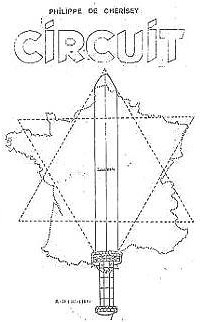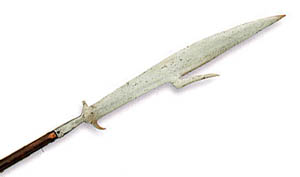Philippe de Chérisey's “Gladio” in Circuit
Paul Smith
26 December 2012
Amended 14 February 2015
The cover to Philippe de Chérisey's 1971 document Circuit shows a Gladio over a hexagram over the map of France.

The Gladio is a reference to the “Mort Épée” keyword to the decoding of the Large Parchment that was also fabricated by Philippe de Chérisey.
The appendix to Circuit (called “L'Alibi d'O”) reproduces the Large Parchment and gives the technical details on how it is to be decrypted by using the keyword “Mort Épée”. A story is developed out of a various mixture of elements found in the Large Parchment. Charlot, the protagonist, searches for a treasure and by scrambling through a sixth niche (the hexagram on the cover of Circuit), discovers a Sepulchre of a Great Roman. The treasure itself is finally discovered, after which is discovered a ruin called the Guardian of the Sword. Charlot explained that the treasure was extremely frightening and that touching it meant death.
* Robert Charroux in his book Trésors du Monde (1962) quoted Noël Corbu about Saunière's alleged treasure saying: “I believe I am right in thinking that there are six entrances leading to the hiding-place”. This was later amplified by Pierre Plantard and Philippe de Chérisey into “Six gateways bearing the seal of the star, here is to be found the treasure of Bérenger Saunière” in the 1964 Priory document attributed to Henri Lobineau, Généalogie des Rois Mérovingiens et Origine des diverses Familles Françaises et Etrangères de Souche Mérovingienne
Operation Gladio Conspiracy Theory
The Priory of Sion has been linked with Operation Gladio. Gladio was the codename for a clandestine NATO “stay-behind” operation in Europe during the Cold War, to continue anti-communist actions in the event of a Soviet invasion and conquest (initially originating in Italy over the fear of the spread of communism there). The Italian word gladius means a type of Roman shortsword, found on Operation Gladio's logo. Operation Gladio appropriated the motto Silendo libertatem servo (“Serving liberty silently”). Formed in 1956, its existence remained a secret until 1991 when first revealed by Italian Prime Minister Giulio Andreotti.
Philippe de Chérisey knew Sean O'Driscoll (Colonel John Joffre Driscoll, USAF, 1915-1991) who worked for NATO. Sean O'Driscoll's wife claimed her husband was godfather to Philippe de Chérisey's son. A former bomber pilot in World War II, O'Driscoll by the 1950s had become the American Head of the NATO Mutual Weapons Development Program (MWDP) in Paris. In 1981 he bought and restored Castle Matrix in Ireland. O'Driscoll was interested in folklore and allegedly co-founded the Irish Heraldry Society (that ceased to exist decades ago). He allegedly belonged to the Shickshinny Order of St John. One acquaintance described O'Driscoll as “a mad Renaissance man” who “collected not only an astounding library, but incredible artefacts”.
The Operation Gladio conspiracy theory is not based on any tangible evidence but on fanciful speculations. The cover of Circuit does show a gladio, but the novel contains no references to politics or to Operation Gladio or to NATO.
Operation Gladio had different names in different countries. For example in Greece it was called Operation Sheepskin. The French parallel Network was called “Glaive” (and not “Gladio”) – a kind of spear :

|

